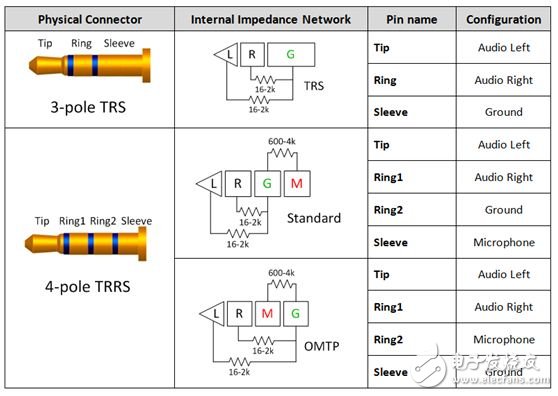In today's automotive electronics applications, engineers are incorporating more and more features inspired by personal electronics. As a result, audio jacks are now appearing in cars. They can be used in rear seat entertainment, detachable navigation devices or automotive grade tablets. When viewing personalized content, passengers often prefer to use their own headphones. This not only protects their personal privacy, but also prevents drivers from distracting when they view content.
The audio jacks for these wired headsets are standard 3.5 mm connectors. In the past, such audio jacks have been three-pin jacks with a tip (TIp), ring, and sleeve pin. As the industry has evolved, more advanced audio entertainment environment systems have progressively implemented button and voice command functions that require a microphone input. In this way, the system must support a four-pin jack with one tip, two rings and a sleeve pin. However, supporting microphones presents a different problem for system designers because there are two quadrupole jacks on the market that have different microphones and grounding locations.

When using commercially available solutions, designers typically have to hardwire the ground to one of the connector pins, making it impossible to support other headphone configurations. This leaves the system's potential end users with incompatible headsets and an unpleasant understanding that they will not be able to listen to their own audio content.
Another feature that a car headset expects to have is a keypad with a button that will be compatible with all headsets. They will have common options such as increasing volume, lowering the volume and a mute button. A typical headset will have a resistor network associated with the button. When the user presses a key, a voltage divider network is formed between the codec's MICBIAS output and the system ground. This will be a measurable voltage on the SLEEVE/RING2 pin. Currently, system designers looking to support these buttons have two options: find a codec with the appropriate detection method and button "bucket", or use a correlation with a resistor divider and voltage network. A suitable external ADC for manual calculations.
A high-performance audio jack switch can help solve these problems by automatically detecting any configuration of the audio headset and routing the ground and microphone lines to the appropriate pins. By observing the resistor network formed by the headphones and microphone of the headset (or without a microphone), the switch series can determine the placement of the ground wire and the microphone. Once the position is determined, the microphone cable from the codec will be automatically routed to the appropriate pins, allowing the system to support every headset on the market.

The main circuit of the equipment is the full bridge controlled circuit and the trigger circuit is the programmable integrated circuit. The phase-shifting, fixed width and modulation of the pulse are all digitized, and it does not need any adjustment for the section of the trigger. It has the features of high reliability, high pulse symmetry, strong anti-interference ability, quick reaction, as well as the advantages of no heat-generating, constant current, energy-saving which is compared with the discharge with the electrical resistance.
AGV Battery Maintenance System
48 Volt Battery Charger,Low Maintenance Agv Battery Charger,Agv Portable Charger Discharger,Agv Battery Maintenance System
Xinxiang Taihang Jiaxin Electric Tech Co., Ltd , https://www.chargers.be